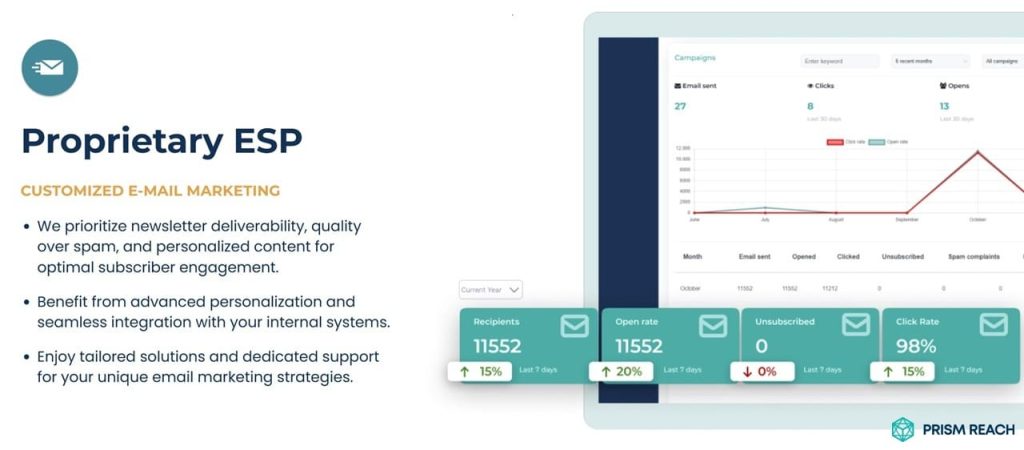In today’s digital landscape, email marketing remains a cornerstone of effective customer engagement and business growth. With an average return on investment (ROI) of $42 for every $1 spent, as reported by recent studies, crafting a well-structured marketing email plan is more crucial than ever. A comprehensive plan not only ensures consistent communication with your audience but also maximizes the impact of your marketing efforts in an era where personalization and relevance are paramount. This article will guide you through the essential steps to create a marketing email plan that drives engagement and conversions, enhanced by innovative strategies and tools like Prism Reach.
Key Facts
- A well-crafted marketing email plan typically includes clear objectives, audience segmentation, content strategy, and performance metrics.
- According to Campaign Monitor, segmented email campaigns can lead to a 760% increase in revenue.
- Implementing a strategic email marketing plan can significantly improve customer retention, with some businesses reporting up to a 25% increase in customer lifetime value.

Your Marketing Email Plan: A Step-by-Step Guide
The foundation of a successful email marketing campaign lies in a well-structured plan. Let’s break down the essential components:
1. Define Your Objectives
Start by clearly outlining what you aim to achieve with your email marketing efforts. Are you looking to increase sales, boost brand awareness, or nurture leads? Defining your objectives is the first crucial step in creating a marketing email plan. As email marketing expert Sarah Johnson states, “Without clear objectives, your email campaign is like a ship without a compass. You need to know where you’re going to chart the right course.” This analogy emphasizes the importance of having well-defined goals to guide your email marketing strategy.
Benefits of Prism Reach for Defining Objectives:
- AI-Powered Personalization: Helps align your objectives with personalized content strategies.
- Predictive Analytics: Assists in setting realistic and data-driven goals.
- Performance Metrics Integration: Facilitates tracking and measuring the success of your objectives.
2. Understand Your Audience
Dive deep into your subscriber data to create detailed buyer personas. This understanding will guide your segmentation strategy, allowing for more personalized and relevant content. Understanding your audience is a critical component of an effective marketing email plan. It involves analyzing your subscriber information to gain insights into their preferences, behaviors, and needs.
Incorporate Behavioral Segmentation:
- Analyze how subscribers interact with your emails and website.
- Create segments based on actions like past purchases, email engagement, and browsing history.
- Use these segments to tailor your email content for higher relevance and engagement.
Prism Reach’s AI technology excels in this area by creating detailed user avatars based on extensive data analysis. These avatars allow for hyper-targeted content delivery, ensuring that each subscriber receives emails that resonate with their specific interests and behaviors.
3. Develop a Content Strategy
Plan your content calendar, ensuring a mix of promotional, educational, and engaging content. As content strategist Mark Thompson advises, “Your email content should provide value in every interaction. It’s not just about selling; it’s about building relationships.” Developing a content strategy is a key element in crafting an effective marketing email plan.
Hidden Gems to Enhance Your Content Strategy:
- Incorporate User-Generated Content: Feature testimonials, reviews, or photos from customers to build trust and authenticity.
- Utilize Interactive Elements: Include quizzes, polls, or surveys to engage readers and gather valuable insights.
- Craft Subject Lines with Curiosity Gaps: Create intrigue by leaving out key information, encouraging recipients to open the email.
Prism Reach’s dynamic content selection feature ensures that each subscriber receives the most relevant content, aligning perfectly with your segmentation strategy. Additionally, the platform’s AI-generated content suggestions and personalized introductions help maintain a diverse and appealing content mix.
4. Set Up Automation Workflows
Implement automated email sequences for various customer touchpoints, such as welcome series, abandoned cart reminders, and post-purchase follow-ups. Setting up automation workflows is an important step in implementing a marketing email plan. This process involves creating automated email sequences that are triggered by specific customer actions or at certain points in the customer journey.
Benefits of Automation:
- Ensures timely and relevant communication without manual intervention.
- Improves efficiency by automating repetitive tasks.
- Enhances personalization through triggered, behavior-based emails.
Prism Reach offers robust automation features, including AI-powered scheduling and event-triggered emails. These tools help you create seamless workflows that respond to subscriber actions in real-time, enhancing engagement and conversion rates.
5. Design for Mobile
With over 60% of email opens occurring on mobile devices, ensure your emails are mobile-responsive. Designing for mobile is a crucial consideration in modern email marketing plans. This step is based on the statistic that a majority of email opens happen on mobile devices. Given this high percentage, making sure that your emails are mobile-responsive is not just an option, but a necessity.
Key Considerations for Mobile Design:
- Use responsive design templates that adapt to different screen sizes.
- Ensure that text is legible without zooming.
- Optimize images and buttons for touch interactions.
Prism Reach’s mobile-friendly previews allow you to see how your emails will render on various devices, ensuring a consistent and engaging experience for all subscribers. Additionally, the platform’s AMP for Email integration enables the creation of interactive and dynamic emails that perform seamlessly on mobile devices.
6. Establish Performance Metrics
Define KPIs such as open rates, click-through rates, and conversion rates to measure the success of your campaigns. Establishing performance metrics is a vital step in creating and maintaining an effective marketing email plan. This process involves defining key performance indicators (KPIs) that will be used to measure the success of your email campaigns.
Essential Performance Metrics:
- Open Rates: Measure how many recipients are opening your emails.
- Click-Through Rates: Track how many recipients are engaging with your content by clicking on links.
- Conversion Rates: Monitor how many recipients are taking the desired action after clicking through.
Prism Reach’s real-time engagement metrics and predictive analytics provide deep insights into these KPIs. The platform’s audience insights heatmap, for example, visualizes user activity times, helping you optimize your send times for maximum engagement.
7. Test and Optimize
Continuously A/B test elements like subject lines, content, and send times to refine your strategy. Testing and optimizing is the final step in the marketing email plan process. This step involves continuously conducting A/B tests on various elements of your emails to gather data on what resonates best with your audience.
Strategies for Effective Testing:
- Subject Lines: Experiment with different styles and tones to see which ones increase open rates.
- Content: Test various types of content, such as images versus text, to determine what drives engagement.
- Send Times: Identify the optimal times to send emails based on when your audience is most active.
Prism Reach’s AI-driven predictive analytics and A/B test results help you make informed decisions. By leveraging these tools, you can continuously optimize your email campaigns for better performance and higher conversion rates.

Integrating Hidden Gems for Enhanced Effectiveness
To further elevate your email marketing plan, consider integrating these five hidden gems strategies:
1. Use Behavioral Segmentation
Go beyond demographic data by segmenting your audience based on their behaviors. Analyze how subscribers interact with your emails and website to create highly targeted campaigns. This approach leads to more relevant content and improved open rates.
2. Implement AMP for Email
Utilize Accelerated Mobile Pages (AMP) technology to create interactive emails that allow recipients to engage directly within the email. Features like carousels, forms, and live updates make the email experience more dynamic and engaging, leading to higher conversion rates.
3. Craft Subject Lines with Curiosity Gaps
Create subject lines that pique curiosity by leaving out key information. For example, “You won’t believe what we have in store for you…” encourages recipients to open the email to satisfy their curiosity, effectively increasing open rates.
4. Incorporate User-Generated Content
Feature testimonials, reviews, or photos from customers within your emails. This builds trust, encourages community engagement, and makes your emails feel more relatable and authentic.
5. Personalize Beyond the First Name
Tailor content based on past interactions, preferences, or location-specific information to create a more personalized experience that resonates with subscribers. Personalized content significantly enhances engagement and loyalty.
Benefits of Prism Reach
Integrating Prism Reach into your email marketing plan offers several advantages:
- Increased Engagement: Publishers report up to 40% higher engagement rates due to the personalized nature of the content.
- Higher Revenue: Tailored advertising and efficient content targeting lead to higher monetization rates for published newsletters.
- Improved Productivity: Automation and AI-driven insights significantly reduce the time required to create and manage campaigns.
Upgrade Your Email Marketing with AI Personalization!
Prism Reach: Enhancing Your Email Marketing Plan
While crafting a marketing email plan is crucial, executing it effectively can be challenging. This is where Prism Reach comes in. Our AI-powered SaaS solution revolutionizes email marketing by offering deep personalization capabilities that can significantly enhance your plan’s effectiveness.
Prism Reach’s advanced AI algorithms analyze subscriber behavior and preferences, allowing for hyper-targeted content delivery. This level of personalization can dramatically improve engagement rates, with some users reporting up to 40% higher engagement.
Moreover, Prism Reach’s dynamic content selection feature ensures that each subscriber receives the most relevant content, aligning perfectly with the segmentation strategy in your email plan. The platform’s AI-enhanced sign-up forms and optimal sending time predictions can also boost your list growth and email open rates.
By integrating Prism Reach into your marketing email plan, you can automate much of the personalization process, saving time while delivering more impactful campaigns. Take your email marketing to the next level and see the difference AI-driven personalization can make in achieving your marketing objectives.

Conclusion
Creating a comprehensive marketing email plan is a critical step in harnessing the full potential of email as a marketing channel. By following a structured approach that includes clear goal-setting, audience understanding, content strategy, and performance measurement, businesses can create email campaigns that truly resonate with their subscribers.
Remember, the key to success lies in continuous optimization and adaptation. As you implement your plan, pay close attention to the data and be ready to adjust your strategy accordingly. With the right approach and tools like Prism Reach, your email marketing efforts can yield significant returns, driving engagement, loyalty, and ultimately, business growth.